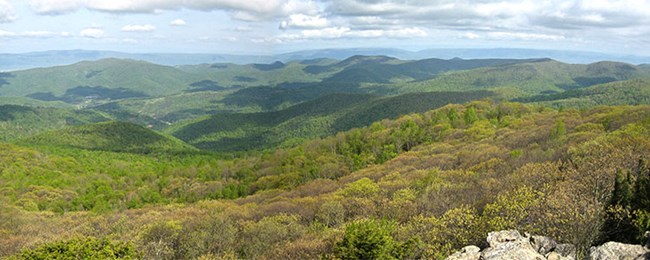
NPS Photo Skyline Drive was designed and constructed in the 1930's to provide scenic views within the park, and into the Piedmont plateau to the east and the Shenandoah Valley to the west. Seventy-six overlooks, and many drive-by vistas were constructed along the drive so motorists could enjoy the views as they toured the park. All overlooks in Shenandoah National Park must be maintained with periodic tree and shrub clearing to maintain the historic views. This clearing work is done within the original footprint of each overlook as it was created during the construction of Skyline drive. Regular vegetation management assures that quality views may be enjoyed by Park visitors for many years to come. Visibility at ShenandoahReports prepared in 1924 and 1925 regarding creation of National Parks in the Appalachian mountains specifically cite interest in protecting views to the west over the Shenandoah Valley and the east over the Piedmont of Virginia. These reports were the basis for the May 22, 1926 legislation establishing Shenandoah National Park Visibility or lack thereof, is a significant issue at Shenandoah National Park related directly to the fundamental purposes of the park. Many visitors to the park spend time on Skyline Drive moving from overlook to overlook taking in the scenery. Other visitors hike to the tops of various peaks in the park. They also take in spectacular views. Unfortunately these experiences are often disrupted due to poor air quality. Park staff members monitor visibility conditions and work with state and federal regulatory agencies to try to limit emissions of pollutants that degrade visibility.Where does haze-forming pollution come from?Air pollutants come from a variety of natural and human-made sources. Natural sources can include windblown dust and soot from wildfires. The Blue Ridge Mountains of the eastern United States have a haze caused by the natural emissions of VOCs from trees and plants (mostly isoprene) which are oxidized and form aerosols. [Graedel, T.D. and Paul Crutzen. Atmospheric Change: an Earth system perspective; 1993; Freeman Press.] Human-made sources can include motor vehicles, electric utility and industrial fuel burning, and manufacturing operations.Some haze-causing particles are directly emitted to the air. Others are formed when gases emitted to the air form particles as they are carried many miles from the source of the pollutants. A string of hot, humid, and stagnant summer days provides ideal conditions for the production and accumulation of particle sulfur and, consequently, poor visibility. In general, a much greater fraction of gaseous sulfur emissions convert to particle sulfur in summer than in winter. Some of the pollutants which form haze have also been linked to serious health problems and environmental damage. Exposure to very small particles in the air has been linked with increased respiratory illness, decreased lung function, and even premature death. In addition, particles such as nitrates and sulfates contribute to acid deposition (need to link to deposition page) formation which makes lakes, rivers, and streams unsuitable for many fish, and erodes buildings, and historical monuments. |
Last updated: September 25, 2018
